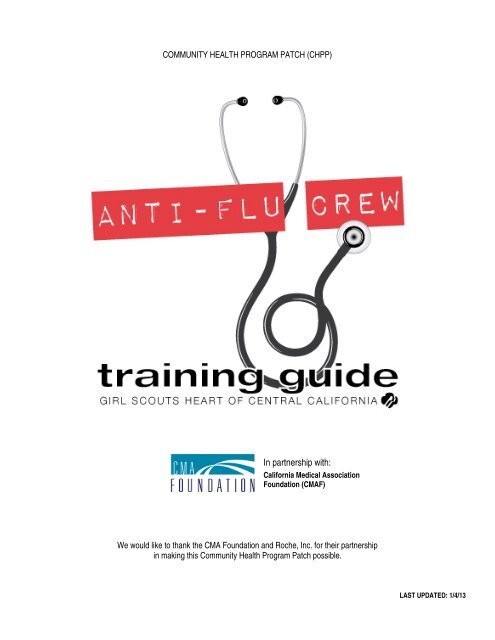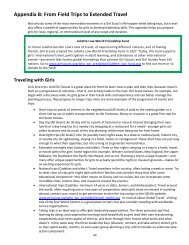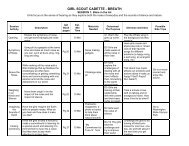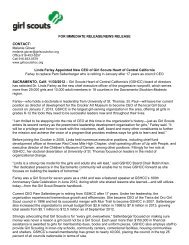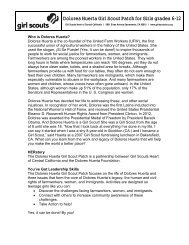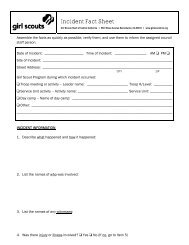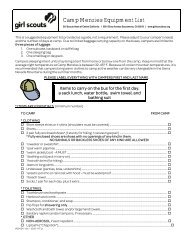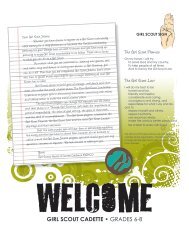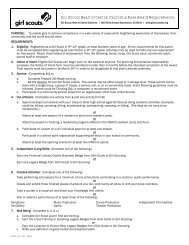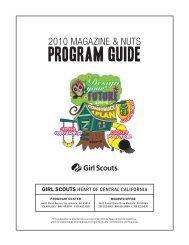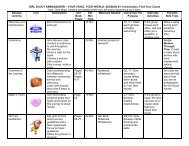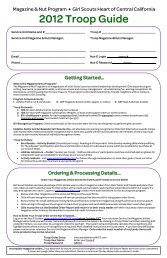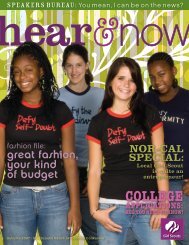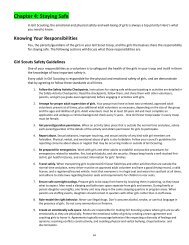Wash the Germs Away - Girl Scouts Heart Of Central California
Wash the Germs Away - Girl Scouts Heart Of Central California
Wash the Germs Away - Girl Scouts Heart Of Central California
Create successful ePaper yourself
Turn your PDF publications into a flip-book with our unique Google optimized e-Paper software.
COMMUNITY HEALTH PROGRAM PATCH (CHPP)<br />
In partnership with:<br />
<strong>California</strong> Medical Association<br />
Foundation (CMAF)<br />
We would like to thank <strong>the</strong> CMA Foundation and Roche, Inc. for <strong>the</strong>ir partnership<br />
in making this Community Health Program Patch possible.<br />
LAST UPDATED: 1/4/13
Table of Contents<br />
Ready!<br />
Set!<br />
Teach!<br />
1. Introduction……………………………………………………………………………..............3<br />
2. Acknowledgments<br />
1. Facilitator Training……………………………………………………………………………….5<br />
2. Top 10 Tips for Successful Instruction<br />
[ PART 1 ]<br />
DISCOVER: <strong>Germs</strong>……………………………………………………………………………………………………8<br />
1. Introduction<br />
2. Required Activity: Draw A Germ<br />
Optional Activity: <strong>Germs</strong> Under A Microscope<br />
3. Discussion: What Are <strong>Germs</strong>?<br />
Optional Activity: Viruses vs. Bacteria Worksheet<br />
4. Discussion: What Is Influenza?<br />
5. Required Activity: The Spread of <strong>Germs</strong> Game<br />
Optional Activity: Make Your Own Game<br />
6. Concluding Thoughts<br />
[ PART 2 ]<br />
CONNECT: Hand & Health Hygiene……………………………………………………………………………25<br />
1. Introduction<br />
2. Discussion: Influenza Prevention<br />
3. Required Activity: Handwashing Demonstration<br />
Optional Activity: Handwashing Chart<br />
Optional Activity: Glogerm® Demonstration<br />
Optional Activity: Germ Experiment<br />
4. Discussion: Handwashing<br />
5. Required Activity: <strong>Wash</strong> <strong>the</strong> <strong>Germs</strong> <strong>Away</strong>! Song<br />
Optional Activity: Write Your Own Song<br />
6. Concluding Thoughts: Influenza Prevention & Management<br />
[ PART 3 ]<br />
TAKE ACTION………………………………………………………………………………………………..............33<br />
A. Inform Your Community<br />
1. Introduction<br />
2. Required Activity: Create Posters<br />
Optional Activity: Create Your Own Activity<br />
3. Concluding Thoughts<br />
4. Required Activity: Worksheets<br />
5. Required Activity: Letter to Parent/Guardian<br />
B. Educate Your Community<br />
1. Introduction<br />
2. Required Activity: Educate<br />
a. Activity: Teach O<strong>the</strong>r <strong>Girl</strong> <strong>Scouts</strong><br />
b. Activity: Teach Senior Centers<br />
c. Activity: Teach Family Members and Friends<br />
3. Required Activity: Participate<br />
Optional Activity: O<strong>the</strong>r Ways to Participate<br />
Evaluation and Order Form…………………………………………………………………………............47<br />
NOTE: All “Required Activities” are mandatory to receive patch.<br />
2
Introduction<br />
In partnership with <strong>the</strong> <strong>California</strong> Medical Association (CMA) Foundation, <strong>the</strong> Community Health Program Patch (CHPP)<br />
was designed to teach girls to take pride in <strong>the</strong>mselves and <strong>the</strong> importance of keeping <strong>the</strong>ir bodies healthy. By staying<br />
healthy, <strong>the</strong> girls can help protect <strong>the</strong>ir community by reducing <strong>the</strong> spread of illnesses. Empowering girls with this<br />
knowledge and reinforcing <strong>the</strong>se messages throughout <strong>the</strong>ir development will promote healthy behaviors that will last<br />
<strong>the</strong>m a lifetime.<br />
The CHPP curriculum will accomplish three objectives:<br />
DISCOVER <strong>the</strong> characteristics of germs, <strong>the</strong> relationship between germs and sickness and <strong>the</strong> ways in<br />
which germs can spread.<br />
CONNECT Prevent influenza and <strong>the</strong> spread of germs through proper handwashing and practicing good<br />
respiratory hygiene.<br />
TAKE ACTION and educate o<strong>the</strong>r <strong>Girl</strong> <strong>Scouts</strong>, peers, family members and seniors on influenza and<br />
respiratory illness prevention, recognition and management.<br />
The girls will learn about germs and obtain basic knowledge of bacteria and virus infections. This information is relevant in order for<br />
<strong>the</strong> girls to understand how illnesses manifest <strong>the</strong>mselves and why <strong>the</strong>y are treated differently. An interactive germ activity will<br />
demonstrate how easily germs are spread and can cause illness in an individual. Understanding this background information enables<br />
<strong>the</strong> girls to prevent respiratory illnesses, including influenza.<br />
The second component of <strong>the</strong> CHPP curriculum empowers <strong>the</strong> girls to be proactive about <strong>the</strong>ir health. The handwashing activity, uses<br />
cinnamon and oil or GloGerm®, allows <strong>the</strong> girls to actually see germs on <strong>the</strong>ir hands before and after washing. Seeing this<br />
demonstration reinforces <strong>the</strong> importance of proper handwashing to prevent disease. Good respiratory hygiene will be discussed to<br />
encourage girls to cover <strong>the</strong>ir cough and sneeze with a tissue or <strong>the</strong>ir sleeve. These basic hygiene practices will ensure that <strong>the</strong> girls<br />
decrease <strong>the</strong>ir risk of getting sick and spreading illnesses to o<strong>the</strong>rs.<br />
Once empowered with <strong>the</strong> knowledge and skills to prevent illnesses and influenza, <strong>the</strong> girls can share this information with <strong>the</strong>ir<br />
community. Organically, <strong>the</strong> girls will begin to recognize opportunities to educate <strong>the</strong>ir peers, family members, seniors and o<strong>the</strong>r<br />
community members. In <strong>the</strong> final component of <strong>the</strong> CHPP curriculum, <strong>the</strong> girls will have specific instances in which <strong>the</strong>y can teach<br />
younger <strong>Girl</strong> <strong>Scouts</strong> <strong>the</strong> handwashing song or alternatively present this information to <strong>the</strong>ir peers, family members and seniors. Taking<br />
influenza and illness prevention information back into <strong>the</strong> community promotes <strong>the</strong> leadership development of each <strong>Girl</strong> Scout.<br />
Moreover, she can become an integral part of a larger public health movement!<br />
The Community Health Program Patch provides invaluable knowledge and skills that girls will practice and share for a lifetime! Get<br />
your <strong>Girl</strong> Scout to join <strong>the</strong> Anti-Flu Crew!<br />
3
Acknowledgments<br />
The Community Health Program Patch was created in partnership with <strong>the</strong><br />
<strong>California</strong> Medical Association Foundation<br />
3835 North Freeway Blvd., Suite 100<br />
Sacramento, <strong>California</strong> 95834<br />
(916) 779-6620 | cmaf@<strong>the</strong>cmafoundaion.org<br />
www.<strong>the</strong>cmafoundaion.org<br />
Author:<br />
Shannon K. Eldridge<br />
CMA Foundation<br />
With Contribution from:<br />
Cindy Lin, MD<br />
4
Facilitator Information<br />
Ready!<br />
This comprehensive curriculum is designed to offer troop leaders <strong>the</strong> necessary information to educate <strong>Girl</strong> Scout Juniors about germs,<br />
illness prevention, proper handwashing and <strong>the</strong> value of living healthy lives. The girls will educate <strong>the</strong>ir local community, including <strong>the</strong>ir<br />
peers, family members and seniors, on how to prevent <strong>the</strong> spread of influenza and o<strong>the</strong>r respiratory illnesses.<br />
Set!<br />
Each section provides a detailed explanation of each activity along with <strong>the</strong> materials that are necessary to complete each lesson.<br />
Instructors should prepare <strong>the</strong>mselves to answer questions knowledgeably and to locate informational resources. Educational materials<br />
are great resources for instructors to build <strong>the</strong>ir knowledge of <strong>the</strong> topics covered in this program. Supplementary resources for<br />
teachers, parents and children are available on <strong>the</strong> AWARE website at www.aware.md.<br />
Teach!<br />
The curriculum is divided into three main sections: 1) DISCOVER – <strong>Germs</strong>, 2) CONNECT - Hand and Health Hygiene and 3) TAKE<br />
ACTION – A. Inform Your Community and B. Educate Your Community. All instructions given in this packet are suggestions, not<br />
requirements! Please adjust <strong>the</strong> process to best meet <strong>the</strong> needs of your troop.<br />
The curriculum is designed to also introduce new words and expand <strong>the</strong> vocabulary of <strong>Girl</strong> <strong>Scouts</strong>. A list of terms and <strong>the</strong>ir definitions<br />
is provided to <strong>the</strong> facilitator. As <strong>the</strong>y appear in <strong>the</strong> curriculum, it is suggested you write <strong>the</strong> new word or term on <strong>the</strong> board so <strong>the</strong> girls<br />
can see <strong>the</strong> spelling and learn how to pronounce <strong>the</strong> word. You will notice that <strong>the</strong>re are sections in <strong>the</strong> curriculum that are italicized.<br />
The italicized sentences are cues for you to communicate instructions, questions and explanations to <strong>the</strong> <strong>Girl</strong> <strong>Scouts</strong>. It is<br />
recommended that this language be used as concepts have been written to be age appropriate.<br />
Three instructors are recommended to complete <strong>the</strong> Community Health Program Patch. Each session can be lead by a different<br />
instructor to distinguish <strong>the</strong> topics. The o<strong>the</strong>r two instructors can be available to write vocabulary words on <strong>the</strong> board, hand out<br />
materials and float around <strong>the</strong> room to assist <strong>the</strong> girls. However, after reading <strong>the</strong> curriculum materials, a troop leader can facilitate on<br />
her/his own.<br />
If this program is being held at a Service Unit Level, a large group of volunteers is not necessary for teaching this lesson at a Service<br />
Unit Level; between three to six well-trained and dedicated instructors are more than enough.<br />
Recruiting Volunteer Facilitators!<br />
Volunteers can be non-<strong>Girl</strong> Scout affiliated. Parents/guardians may be asked to assist with <strong>the</strong> facilitation. If implementing <strong>the</strong> CHPP<br />
at <strong>the</strong> service unit level, troop leaders may also be asked to lead one of <strong>the</strong> sections. Existing volunteer placement organizations can<br />
be a great resource to identify volunteers. Such organizations include high schools, colleges/universities or public service resource<br />
centers. <strong>Of</strong>ten students have community service requirements and can fulfill those hours by volunteering with your troop.<br />
Posting flyers with an email contact or orientation meeting date around <strong>the</strong> campus or in health sciences buildings may be ano<strong>the</strong>r<br />
good way to find instructors. Set up a table at a student orientation or activity fair to recruit volunteers. Contact principals, school<br />
counselors, activity directors, or associated student body members to have <strong>the</strong>m spread <strong>the</strong> word.<br />
5
Facilitator Training<br />
Once several persons have expressed interest in teaching <strong>the</strong> Community Health Program Patch (CHPP), you may want to hold an<br />
orientation/training session. The purpose of this hour-long session is to introduce instructors to <strong>the</strong> lesson and to teach <strong>the</strong>m how to<br />
teach <strong>the</strong> lesson. If funds are available, providing snacks is always a great incentive for people to attend!<br />
Preparation for Training<br />
1. Start <strong>the</strong> session by giving a general background description of <strong>the</strong> lesson:<br />
• length of time (approximately 1 hour per section)<br />
• age group<br />
• objectives<br />
• main messages<br />
2. Mention some of <strong>the</strong> activities and describe <strong>the</strong> role and commitment of <strong>the</strong> instructors. Talk to <strong>the</strong> instructors about how <strong>the</strong><br />
most important factor in <strong>the</strong> successful teaching of <strong>the</strong> curriculum is <strong>the</strong> ability of <strong>the</strong> instructors to assess and adjust to <strong>the</strong><br />
understanding level of <strong>the</strong> girls and to get <strong>the</strong> girls excited about <strong>the</strong> lesson topics.<br />
3. Bring copies of <strong>the</strong> Community Health Program Patch (CHPP) Training Guide, Community Health Program Patch (CHPP)<br />
Quick Guide along with activity materials.<br />
4. After giving an introduction, hand out copies of <strong>the</strong> materials and review <strong>the</strong> main parts and activities. Give <strong>the</strong> instructors<br />
some time to read and familiarize <strong>the</strong>mselves with <strong>the</strong> materials.<br />
Day of Training<br />
1. Have <strong>the</strong> volunteer facilitators form groups of three. As <strong>the</strong> volunteer trainer/leader, you can act as one of <strong>the</strong> three instructors<br />
in a group if needed.<br />
2. Divide up <strong>the</strong> lesson for each instructor to teach one part.<br />
3. As a group, <strong>the</strong> instructors should practice <strong>the</strong> lesson out loud from top to bottom, pretending that <strong>the</strong> o<strong>the</strong>r instructors are<br />
troop members. The instructors should practice <strong>the</strong> entire lesson including posing questions to <strong>the</strong> group setting and miming<br />
<strong>the</strong> activities without <strong>the</strong> props. After running through <strong>the</strong> Community Health Program materials, read <strong>the</strong> Top 10 Teaching<br />
Tips and allow time for questions.<br />
4. Encourage each of <strong>the</strong> instructors to research <strong>the</strong> main topics of <strong>the</strong> lesson, using <strong>the</strong> supplementary resources list as a<br />
springboard. This will prepare <strong>the</strong> instructors to become “experts” on <strong>the</strong> topics to teach o<strong>the</strong>r instructors and to answer<br />
questions.<br />
5. It may also be helpful to create a contact list of all newly trained instructors who can share teaching techniques and answer<br />
fur<strong>the</strong>r questions that may come up. Now you’re ready to teach!<br />
6
Top 10 Tips for Successful Instruction<br />
1. REPETITION. Repeat and summarize <strong>the</strong> main messages and responses given by <strong>the</strong> girls. Write <strong>the</strong>m on <strong>the</strong> board.<br />
2. OUTLINE. Write an outline of <strong>the</strong> lesson in <strong>the</strong> background including <strong>the</strong> main parts and activities of <strong>the</strong> lesson. Check off<br />
<strong>the</strong> parts and activities as you complete <strong>the</strong>m so <strong>the</strong> girls can follow along.<br />
3. MAINTAIN ATTENTION OF THE GIRLS. Remind <strong>the</strong> girls that <strong>the</strong> instructor will only call on those who are raising <strong>the</strong>ir<br />
hands and sitting quietly in <strong>the</strong>ir seats. If <strong>the</strong> troop is rambunctious, after <strong>the</strong> instructors introduce <strong>the</strong>mselves, it may be<br />
helpful to establish that <strong>the</strong>y will learn a lot of interesting things today and play some fun activities, but it is important that <strong>the</strong>y<br />
listen, follow instructions and raise <strong>the</strong>ir hands if <strong>the</strong>y have a question.<br />
4. LEARN HOW TO IMPROVE AS AN INSTRUCTOR. After teaching a lesson, instructors should take some time to<br />
discuss how <strong>the</strong>y felt <strong>the</strong> instruction went and share comments on how particular activities worked. It’s okay to do it differently<br />
next time.<br />
5. INTRODUCE VOCABULARY WORDS. Repeat <strong>the</strong> definitions of challenging vocabulary words. Write <strong>the</strong>se words out<br />
and point to <strong>the</strong>m when referring to words such as virus, viruses, bacterium and bacteria.<br />
6. BE CREATIVE. Be creative when explaining challenging concepts and getting <strong>the</strong> girls excited about <strong>the</strong> lesson. For<br />
example, one way to explain <strong>the</strong> word “antibiotic” is to break it down into its root and prefix. “Anti” means to fight against and<br />
“biotic” means a living thing, such as a germ.<br />
7. ACCURACY OF RESPONSES. It is important to encourage and praise <strong>the</strong> girls when <strong>the</strong>y participate. If <strong>the</strong>y offer an<br />
incorrect answer, gently provide <strong>the</strong> correct response.<br />
8. CHECK FOR UNDERSTANDING. Ask questions to check for understanding and to keep <strong>the</strong> girls engaged and following<br />
along. Allowing only a few of <strong>the</strong> girls to respond to each question can keep <strong>the</strong> pace of <strong>the</strong> lesson moving along. If <strong>the</strong> girls<br />
are having trouble responding to a question, rephrase <strong>the</strong> question or give <strong>the</strong>m clues to help <strong>the</strong>m respond.<br />
9. SPEAK UP. All instructors should speak at a volume that is audible to all <strong>the</strong> girls and that gets <strong>the</strong> attention of <strong>the</strong> Troop.<br />
Do not speak too fast.<br />
10. CHECK YOUR VOCABULARY. Choose words that are age appropriate and ensure understanding of <strong>the</strong> Troop. To test<br />
comprehension, ask <strong>the</strong> girls to explain in <strong>the</strong>ir own words what you said.<br />
HAVE FUN!!!<br />
7
[ P A R T 1 ]<br />
DISCOVER: <strong>Germs</strong><br />
[ Approximate Time: 1 hour ]<br />
1. Introduction:<br />
*Tip* Inform <strong>the</strong> girls to raise <strong>the</strong>ir hands quietly if <strong>the</strong>y wish to respond to a question. Choose only a few different girls each<br />
time to respond to a question to keep <strong>the</strong> pace of <strong>the</strong> lesson moving along.<br />
A. To get <strong>the</strong> girls thinking about germs, ask <strong>the</strong> girls <strong>the</strong> following questions:<br />
What are germs? OR Have you heard <strong>the</strong> word germ?<br />
Think back to <strong>the</strong> last time you were sick. How did you feel?<br />
Do you know why you got sick? OR What made you sick?<br />
Expanding Vocabulary: Write on <strong>the</strong> board and review <strong>the</strong> term “germ.”<br />
Objective:<br />
Today you will learn about germs, influenza, and <strong>the</strong> importance of handwashing and <strong>the</strong> value of your health. Also, you will<br />
learn how keeping yourself healthy helps protect o<strong>the</strong>rs around from getting sick. This includes your troop, your classmates<br />
and your family. In addition, you can help keep your grandparents or elders healthy since <strong>the</strong>y may not be able to fight illness<br />
as easily as you can.<br />
2. Required Activity: Draw A Germ<br />
Materials:<br />
Pencils or Markers<br />
Paper<br />
Instructions:<br />
1. Pass out a sheet of paper and pencil or marker to each girl.<br />
2. Ask <strong>the</strong> girls to trace <strong>the</strong>ir hand.<br />
3. Then ask <strong>the</strong> girls to draw a germ – how <strong>the</strong>y think it looks and its size. Encourage <strong>the</strong>m to use <strong>the</strong>ir imagination and give<br />
<strong>the</strong>m 4 minutes to complete this drawing.<br />
Explain: <strong>Germs</strong> are things that can make us sick. What do you think something that makes you feel sick looks like?<br />
Draw it.<br />
4. Have <strong>the</strong> girls compare <strong>the</strong>ir germs with o<strong>the</strong>r troop members to see who drew <strong>the</strong> smallest germ.<br />
5. Ask for a volunteer to draw <strong>the</strong> “smallest germ” on <strong>the</strong> board. (They can use <strong>the</strong> back side of <strong>the</strong>ir paper if no board is<br />
available.)<br />
Explain: <strong>Germs</strong> are smaller than a pencil dot on <strong>the</strong>ir paper. <strong>Germs</strong> are so small <strong>the</strong>y cannot be seen with <strong>the</strong> eyes alone<br />
and can only be seen under a microscope.<br />
There are two main types of germs that make us feel sick (cause illness), virus and bacterium. Viruses and bacteria<br />
come in different shapes and sizes.<br />
Expanding Vocabulary: Write on <strong>the</strong> board and review <strong>the</strong> terms “virus” “viruses” and “bacterium” “bacteria.”<br />
8
Optional Activity: <strong>Germs</strong> Under A Microscope<br />
Materials:<br />
Germ transparencies/pictures<br />
Instructions:<br />
1. View <strong>the</strong> germ transparencies/pictures.<br />
2. Discuss <strong>the</strong> different parts of a virus and a bacterium using <strong>the</strong> included diagrams.<br />
3. Use <strong>the</strong> included “relative sizes” chart to determine <strong>the</strong> real size of a virus and a bacterium.<br />
4. This activity can help to complete <strong>the</strong> optional “Viruses vs. Bacteria Worksheet” activity found later in part 1.<br />
5.<br />
9
Influenza (<strong>the</strong> flu) Virus<br />
Measles Virus<br />
11
E. coli (Escherichia coli) bacterium<br />
Salmonella Bacterium<br />
15
3. Discussion: What Are <strong>Germs</strong>?<br />
A. Viruses vs. Bacteria<br />
Explain: Even though viruses and bacteria make us feel <strong>the</strong> same, <strong>the</strong>re are differences between <strong>the</strong>m.<br />
Viruses can cause:<br />
• All colds and influenza<br />
• Most coughs<br />
• Most sore throats<br />
(It usually feels worse in <strong>the</strong> morning and can get<br />
better during <strong>the</strong> day. It feels scratchy and hurts to<br />
swallow.)<br />
Viruses usually involve several parts of <strong>the</strong> body. (You<br />
may feel achiness all over.)<br />
Bacteria can cause:<br />
• Strep Throat (It hurts to swallow because your tonsils<br />
are swollen. It is uncomfortable all <strong>the</strong> time)<br />
• Urinary tract infections (Pain with urination)<br />
• Most ear infections (Your ears hurt)<br />
• Some sinus infections (Pain on your face)<br />
A bacterium is usually localized to a single point in <strong>the</strong><br />
body. (The area will be red and swollen.)<br />
B. It is important to emphasize that germs are too small to be seen with <strong>the</strong> naked eye.<br />
C. Ask <strong>the</strong> troop members: Where do you think germs can be found?<br />
Explain: <strong>Germs</strong> exist everywhere. However, not all germs make us sick. Some germs are good and protect our bodies,<br />
keeping us healthy, while o<strong>the</strong>rs are bad and make us sick.<br />
D. Ask <strong>the</strong> troop members: Have you heard of <strong>the</strong> immune system before?<br />
Explain: Your immune system is made up of special cells (white blood cells) in your blood that fight off and kill <strong>the</strong> bad<br />
germs that enter your body. We can all help to keep our immune systems strong by exercising, eating healthy and<br />
getting plenty of sleep.<br />
Expanding Vocabulary: Write on <strong>the</strong> board and review <strong>the</strong> terms “infection” and “immune system.”<br />
18
Optional Activity: Viruses vs. Bacteria Worksheet<br />
Materials:<br />
Viruses vs. Bacteria Worksheet<br />
Instructions:<br />
1. Compare and contrast how viruses and bacteria are similar and how <strong>the</strong>y are different.<br />
2. View <strong>the</strong> germ transparencies/pictures found in <strong>the</strong> optional “<strong>Germs</strong> Under A Microscope” activity found earlier in part 1 to assist<br />
you in completing this activity.<br />
3. Discuss <strong>the</strong> different parts of <strong>the</strong> germs using <strong>the</strong> diagrams of a virus and a bacterium.<br />
19
Viruses vs. Bacteria Worksheet<br />
Viruses<br />
A virus is smaller than a bacterium.<br />
Both cause disease.<br />
A bacterium is bigger than a virus.<br />
Bacteria<br />
20
4. Discussion: What Is Influenza?<br />
A. What is influenza?<br />
Explain: Influenza is also known as “<strong>the</strong> flu” – It is a sickness caused by a virus. The flu is transferred from one person to<br />
ano<strong>the</strong>r. When a person who has <strong>the</strong> flu, coughs or sneezes into <strong>the</strong> air, <strong>the</strong> virus travels in <strong>the</strong> air and can enter<br />
someone else’s body. It usually enters <strong>the</strong> body through <strong>the</strong> mouth, nose or eyes. Once <strong>the</strong> flu is in <strong>the</strong> body, <strong>the</strong><br />
immune system attempts to kill <strong>the</strong> virus. If it is unable to kill <strong>the</strong> virus, you start to feel sick within 1-2 days.<br />
Explain: Influenza (<strong>the</strong> flu) season usually begins in October and ends in May.<br />
Expanding Vocabulary: Write on <strong>the</strong> board and review <strong>the</strong> term “influenza.”<br />
B. Symptoms of <strong>the</strong> flu include:<br />
• Headache<br />
• Runny Nose<br />
• Dry Cough<br />
• Sore Throat<br />
• Fever<br />
• Feel Tired<br />
• General Achiness<br />
Expanding Vocabulary: Write on <strong>the</strong> board and review <strong>the</strong> term “symptom.”<br />
C. Ask <strong>the</strong> troop members: Do you know how germs are spread?<br />
Explain: We will now have <strong>the</strong> opportunity to play a game that demonstrates how easily germs are spread.<br />
21
5. Required Activity: The Spread of <strong>Germs</strong> Game<br />
Materials:<br />
Colored Paper to make cards<br />
Scissors<br />
Game Instructions<br />
Rubber bands, Paperclips or Envelopes<br />
A. The girls will play The Spread of <strong>Germs</strong> game. (See game instructions.)<br />
B. Number of participants: 6+<br />
a. Small troops are encouraged to invite more participants to play <strong>the</strong> game.<br />
b. Large troops are encouraged to team up girls to play <strong>the</strong> game.<br />
22
The Spread of <strong>Germs</strong> Game Instructions Number of participants: 6+<br />
Game Objectives:<br />
1. <strong>Girl</strong>s will learn that germs can be found on <strong>the</strong> hands<br />
2. <strong>Girl</strong>s will learn <strong>the</strong> ways in which germs can spread<br />
3. <strong>Girl</strong>s will learn that proper handwashing can reduce illness causing germs on <strong>the</strong> hands<br />
Game Set-up:<br />
1. Prepare game cards; one different color paper for each participant.<br />
2. Cut each piece of paper into 6 equally sized “cards;” make a set of 6 cards for each girl.<br />
3. Laminate <strong>the</strong> cards if <strong>the</strong>y will be reused.<br />
4. The rubber band, paperclip or envelope will keep each set toge<strong>the</strong>r.<br />
Game Instructions:<br />
1. There are both good and bad germs. The leader will secretly choose <strong>the</strong> color of <strong>the</strong> “cards” that will represent <strong>the</strong> “flu” cards which<br />
symbolize bad germs in this game.<br />
2. Pass out a set of six of <strong>the</strong> same color cards to each girl. Each girl should receive 1 complete set of 6 cards.<br />
3. The girls should keep one card from <strong>the</strong>ir assigned color for <strong>the</strong> duration of <strong>the</strong> game.<br />
4. Each girl will walk around <strong>the</strong> room and (1) shake hands with ano<strong>the</strong>r girl and (2) trade a card. They will continue to do this until<br />
<strong>the</strong>y have traded all 5 of <strong>the</strong>ir cards. Each girl will finish <strong>the</strong> game with 5 “new” cards.<br />
*Tip* Model <strong>the</strong> exchange. Shake hands with one of <strong>the</strong> girls and <strong>the</strong>n exchange one of your cards for one of <strong>the</strong>irs.<br />
5. The girls will continue shaking hands and trading cards until 5 cards have been exchanged. When <strong>the</strong>y are finished trading, <strong>the</strong>y<br />
should return back to <strong>the</strong>ir seated position.<br />
6. After <strong>the</strong> game has ended, identify <strong>the</strong> person who started with <strong>the</strong> “flu card” color (that <strong>the</strong> leader secretly chose at <strong>the</strong> beginning<br />
of <strong>the</strong> game). This was <strong>the</strong> troop member that was “sick” and may not have been aware of it. Write her name on <strong>the</strong> board if<br />
available or have her stand. (See diagram in “Concluding Thoughts” section)<br />
7. Identify <strong>the</strong> girls who “received <strong>the</strong> flu” by trading cards with <strong>the</strong> girl who was identified in #6. Ask <strong>the</strong>m to hold up <strong>the</strong>ir “flu card.”<br />
Write <strong>the</strong>ir names branching out from <strong>the</strong> girl who originally had <strong>the</strong> “flu cards” if available or ask <strong>the</strong>m to stand. (See diagram in<br />
“Concluding Thoughts” section)<br />
8. Identify <strong>the</strong> girls who received a card from <strong>the</strong> girls who were identified in #7. They have also “received <strong>the</strong> flu” by trading cards<br />
with <strong>the</strong> girl who was identified in #7. Continue until all <strong>the</strong> names are on <strong>the</strong> board or all of <strong>the</strong> girls are standing.<br />
23
Concluding Thoughts:<br />
The Spread of <strong>Germs</strong> Game<br />
Molly<br />
(Flu Cards)<br />
Keep 1<br />
card;<br />
Trade 5<br />
cards.<br />
Sue<br />
Lisa<br />
Rita<br />
Anna<br />
Eve<br />
Direct<br />
Transmission<br />
Continue trading<br />
cards until 5 cards<br />
have been<br />
exchanged.<br />
Each girl will end<br />
up with 5 “new”<br />
cards.<br />
Indirect<br />
Transmission<br />
A. Discuss: It is easy to share germs with o<strong>the</strong>r people. Especially, when we don’t know that our bodies are fighting viruses<br />
or bacteria.<br />
Ask <strong>the</strong> girls <strong>the</strong> following questions:<br />
What did you learn from this game?<br />
What does <strong>the</strong> game show you about how germs and <strong>the</strong> flu spread?<br />
What can we do to prevent <strong>the</strong> spread of germs or <strong>the</strong> flu?<br />
Revisit <strong>the</strong> Game Objectives:<br />
1. <strong>Germs</strong> can be found on <strong>the</strong> hands<br />
2. <strong>Germs</strong> can spread through touch and close contact<br />
3. Proper handwashing can reduce illness causing germ on <strong>the</strong> hands<br />
In our next section, we will spend more time learning how to prevent <strong>the</strong> flu and protect o<strong>the</strong>rs from getting sick.<br />
B. Discuss: <strong>Germs</strong> can spread from person to person and from different things/objects that your hands may touch. <strong>Germs</strong><br />
on your hands alone will not make you sick. Only <strong>the</strong> bad germs that get inside of <strong>the</strong>ir bodies can make us sick.<br />
Thus, we should try not to touch our mouth, nose, or eyes with our hands because that is how germs get inside our<br />
bodies. If you need to, wash your hands.<br />
C. Ask troop members: Do you know o<strong>the</strong>r ways germs can spread?<br />
Explain: <strong>Germs</strong> can also spread germs through <strong>the</strong> air, water, dirt, animals, and food. <strong>Germs</strong> can travel through <strong>the</strong> air<br />
when we sneeze or cough. That is why it is important to cover our nose or mouth with a tissue or our sleeve when we<br />
cough or sneeze. <strong>Germs</strong> can also spread when sharing drinks, food, or using <strong>the</strong> same fork, spoon or straw with o<strong>the</strong>rs.<br />
Interesting Fact: <strong>Germs</strong> fly up to 100 miles an hour when you sneeze!<br />
24
[ P A R T 2 ]<br />
CONNECT: Hand & Health Hygiene<br />
[ Approximate Time: 1 hour ]<br />
1. Introduction:<br />
Explain: In <strong>the</strong> last section we learned about germs, <strong>the</strong> influenza virus and how germs are spread. (Highlight with <strong>the</strong> troop<br />
what was learned in <strong>the</strong> last section.)<br />
*Tip* Instructor can summarize and repeat responses out loud and write <strong>the</strong>m on <strong>the</strong> board.<br />
A. Brainstorm with <strong>the</strong> girls <strong>the</strong> following questions:<br />
Do you know why you should wash your hands?<br />
When should we wash our hands?<br />
Answer: To be clean and to prevent getting sick: after using <strong>the</strong> toilet, before preparing or eating food, after playing<br />
with animals, after touching money, playing outside, coughing, sneezing, or blowing <strong>the</strong>ir nose, before and after<br />
being around sick people and after helping change babies’ diapers.<br />
Objective:<br />
Today you will learn effective handwashing technique, influenza prevention, influenza management and when it is important<br />
to wash your hands.<br />
2. Discussion: Influenza Prevention<br />
A. Brainstorm with <strong>the</strong> girls <strong>the</strong> following question:<br />
How can you prevent <strong>the</strong> spread of germs, like influenza (<strong>the</strong> flu)?<br />
Has anyone received <strong>the</strong> flu vaccine or flu mist?<br />
Answer: washing your hands, covering your nose & mouth when you cough and sneeze and getting <strong>the</strong> influenza<br />
vaccine.<br />
Expanding Vocabulary: Write on <strong>the</strong> board and review <strong>the</strong> terms “vaccine” and “vaccination.”<br />
Explain: The vaccine is meant to prevent you from getting sick. When you receive <strong>the</strong> vaccine you can still get sick. If<br />
you do get sick you will not get as sick. The symptoms will not be as harsh. Remember that you can still spread germs<br />
when you are sick, so handwashing is still encouraged.<br />
B. The single best way to prevent <strong>the</strong> flu is to get a flu vaccination each year.<br />
There are two types of vaccines:<br />
• The "flu shot" – an inactivated vaccine (containing killed virus) that is given with a needle. The flu shot is<br />
approved for use in people 6 months of age and older, including healthy people and people with chronic medical<br />
conditions.<br />
• The nasal-spray flu vaccine – a vaccine made with live, weakened flu viruses that do not cause <strong>the</strong> flu<br />
(sometimes called LAIV for “Live Attenuated Influenza Vaccine”). LAIV is approved for use in “healthy people” 2-<br />
49 years of age who are not pregnant.<br />
About two weeks after vaccination, antibodies develop that protect against influenza virus infection. Flu vaccines will<br />
not protect against flu-like illnesses caused by non-influenza viruses.<br />
25
3. Required Activity: Handwashing Demonstration<br />
Materials:<br />
Cooking oil (Olive, Canola, Vegetable, etc.)<br />
Ground cinnamon<br />
Liquid hand soap bottle (does not have to be antibacterial)<br />
Instant hand sanitizer gel bottle<br />
Sink with cold and warm running water<br />
Clean paper towels<br />
Today we are going to see a special demonstration of handwashing. We need two volunteers to help with this handwashing<br />
demonstration.<br />
Instructions:<br />
1. Go to <strong>the</strong> sink and roll up your sleeves so that hands and wrists are exposed.<br />
2. Rub about 1 tablespoon of cooking oil on your hands like lotion application.<br />
3. Ask your leader to sprinkle approximately half of a tablespoon of ground cinnamon on your hands.<br />
4. Rub <strong>the</strong> cinnamon with oil all over your hands.<br />
5. <strong>Wash</strong>ing Dirty Hands<br />
a. Use one of <strong>the</strong> following practices for washing your hands:<br />
i. <strong>Wash</strong> with cold water for 10 seconds<br />
ii. <strong>Wash</strong> with cold water for 20 seconds<br />
iii. <strong>Wash</strong> with warm water and soap for 10 seconds<br />
iv. <strong>Wash</strong> with warm water and soap for 20 seconds<br />
6. Look at everyone’s hands and see if you can answer <strong>the</strong>se questions:<br />
a. Did <strong>the</strong> cold or <strong>the</strong> warm water remove more of <strong>the</strong> oil and cinnamon from your hands?<br />
b. Did soap help remove more of <strong>the</strong> oil and cinnamon from your hands?<br />
c. How long should you wash your hands to remove <strong>the</strong> oil and cinnamon on your hands?<br />
d. If <strong>the</strong> oil and cinnamon were germs, who would have <strong>the</strong> most germs on <strong>the</strong>ir hands?<br />
Optional Activity: Handwashing Chart<br />
Materials:<br />
Pencils or Markers<br />
Paper<br />
Instructions:<br />
1. Review <strong>the</strong> handwashing chart.<br />
2. Discuss with <strong>the</strong> troop how <strong>the</strong> chart can be used at home to make proper hand washing a good habit!<br />
3. Track how often and when you properly washed your hands.<br />
4. Keep <strong>the</strong> chart in your bedroom or post it outside <strong>the</strong> restroom door.<br />
5. Bring <strong>the</strong> filled in chart to <strong>the</strong> next troop meeting and compare it with your troop!<br />
26
Handwashing Chart<br />
Activity 5<br />
When to<br />
wash hands?<br />
Whenever <strong>the</strong>y<br />
look dirty<br />
Before and after<br />
preparing<br />
food<br />
Before and after<br />
eating food<br />
After playing<br />
(inside or<br />
outside)<br />
After coughing<br />
or sneezing<br />
or blowing my<br />
nose<br />
After using <strong>the</strong><br />
restroom<br />
After touching a<br />
pet<br />
After handling<br />
garbage<br />
Before and after<br />
being<br />
around a sick<br />
person<br />
Monday Tuesday Wednesday Thursday Friday Saturday Sunday<br />
27
Optional Activity: Glogerm® Demonstration<br />
Materials:<br />
Glogerm® Gel<br />
Glogerm® Kit: Glogerm® Gel & Black/Ultra-Violet Light<br />
Location: Moab, Utah 84532<br />
Phone: 1-800-842-6622<br />
Website: www.glogerm.com<br />
Black /Ultra-Violet Light<br />
Liquid hand soap bottle (does not have to be antibacterial)<br />
Instant hand sanitizer gel bottle<br />
Sink with cold and warm running water<br />
Clean paper towels<br />
Today we are going to see a special demonstration of handwashing. We need two volunteers to help with this handwashing<br />
demonstration. In this bottle <strong>the</strong>re are glow-in-<strong>the</strong>-dark fake germs. Rub <strong>the</strong>m all over your hands.<br />
Instructions:<br />
Version 1:<br />
1. Spread <strong>the</strong> recommended quantity of Glogerm® onto <strong>the</strong> girls’ hands.<br />
2. Close <strong>the</strong> curtains turn off <strong>the</strong> lights and turn on <strong>the</strong> black light to show <strong>the</strong> fake germs on <strong>the</strong> girl’s hands.<br />
3. Turn <strong>the</strong> lights back on and ask <strong>the</strong> two girls to wash <strong>the</strong>ir hands.<br />
4. Close <strong>the</strong> curtains, turn off <strong>the</strong> lights, turn on <strong>the</strong> black light to show <strong>the</strong> fake germs that remain on <strong>the</strong> girls hands. This activity<br />
helps to illustrate that while we are washing our hands, we need to make sure that we take <strong>the</strong> time to do it right.<br />
Version 2:<br />
1. Alternatively, <strong>the</strong> group can be split in two. Half of <strong>the</strong> girls can spread <strong>the</strong> recommended quantity of Glogerm® onto <strong>the</strong>ir hands.<br />
The o<strong>the</strong>r half can leave <strong>the</strong>ir hands bare.<br />
2. The half of <strong>the</strong> group that has <strong>the</strong> Glogerm® on <strong>the</strong>ir hands can shake hands with <strong>the</strong> bare handed girls.<br />
3. Close <strong>the</strong> curtains, turn off <strong>the</strong> lights and turn on <strong>the</strong> black light to show how <strong>the</strong> fake germs on <strong>the</strong> girl’s hands spread with<br />
shaking hands. This activity helps to illustrate how easily germs can spread from girl to girl.<br />
4. Turn <strong>the</strong> lights back on and ask <strong>the</strong> two girls to wash <strong>the</strong>ir hands.<br />
5. Close <strong>the</strong> curtains, turn off <strong>the</strong> lights, turn on <strong>the</strong> black light to show <strong>the</strong> fake germs that remain on <strong>the</strong> girls hands. This activity<br />
helps to illustrate that while we are washing our hands we need to make sure that we take <strong>the</strong> time to do it right.<br />
28
Optional Activity: Germ Experiment<br />
Materials:<br />
Apples (2 slices for each girl)<br />
Jars (2 for each girl) OR Resalable plastic bag (2 for each girl)<br />
Liquid Hand Soap Bottle (does not have to be antibacterial)<br />
Instant Hand Sanitizer Gel Bottle<br />
Sink with cold and warm running water<br />
Clean paper towels<br />
Instructions:<br />
1. Take two apple pieces.<br />
2. <strong>Wash</strong> one apple piece and <strong>the</strong>n wipe it with dirty hands and place it in a sealed jar or sealed plastic bag.<br />
3. Label <strong>the</strong> jar/bag "dirty hands."<br />
4. Now wash your hands.<br />
5. Take a second apple piece and wash it, <strong>the</strong>n wipe it with your clean hands.<br />
6. Label this jar/bag "squeaky-clean."<br />
7. After one week, look at both apple pieces.<br />
8. Ask <strong>the</strong> girls <strong>the</strong> following questions:<br />
Are <strong>the</strong>re any differences?<br />
How does this experiment demonstrate <strong>the</strong> importance of washing your hands?<br />
29
4. Discussion: Handwashing<br />
A. Ask <strong>the</strong> girls <strong>the</strong> following question:<br />
Can somebody describe what you do when you wash your hands? (Allow a few girls to share <strong>the</strong>ir handwashing technique.)<br />
Explain: The best way to wash your hands to get rid of <strong>the</strong> bad germs is with soap and water. It is important to wash your<br />
hands <strong>the</strong> right way because even if your hands look clean, <strong>the</strong>re still may be some bad germs on <strong>the</strong>m. Remember, germs<br />
are so small that we cannot see <strong>the</strong>m with our eyes.<br />
B. Show <strong>the</strong> girls a bottle of regular soap and of instant hand sanitizer gel.<br />
C. Ask <strong>the</strong> girls <strong>the</strong> following question:<br />
Have you seen instant hand sanitizer gel before?<br />
When do you use it? (Allow a few girls to share.)<br />
Explain: Hand sanitizer gel can be used as an alternative when soap and water are not immediately available.<br />
<strong>Germs</strong> on your hands do not always make you sick. There are both good and bad germs. You can get sick if <strong>the</strong><br />
bad germs from your hands get inside your body through your mouth, nose, or eyes. If your immune system<br />
cannot fight <strong>the</strong>m off, <strong>the</strong>n you will start to feel sick. It is important that you do not touch your face, stick your fingers<br />
in your mouth or nose, or rub your eyes too often. If you have too, wash your hands!<br />
Expanding Vocabulary: Write on <strong>the</strong> board and review <strong>the</strong> term “sanitizer.”<br />
D. When using an alcohol-based hand sanitizer:<br />
• Apply product to <strong>the</strong> palm of one hand<br />
• Rub hands toge<strong>the</strong>r<br />
• Rub <strong>the</strong> product over all surfaces of hands and fingers until hands are dry.<br />
E. Handwashing (Review <strong>the</strong> steps)<br />
• Wet your hands with clean running water and apply soap. Use warm water if available.<br />
• Rub hands toge<strong>the</strong>r to make bubbles on all sides of your hands and fingers.<br />
(There are four sides: front, back, left and right.)<br />
• Rub your hands for 20 seconds. You can sing <strong>the</strong> "Happy Birthday" song twice.<br />
• Rinse your hands to get <strong>the</strong> soap off.<br />
• Dry your hands using a paper towel or hand dryer. If possible, use your paper towel to turn off <strong>the</strong> faucet.<br />
Reminder: If soap and water are not available, use alcohol-based hand sanitizer gel to clean hands.<br />
F. Ask <strong>the</strong> girls <strong>the</strong> following question: When should you wash your hands?<br />
• Before preparing or eating food<br />
• After going to <strong>the</strong> bathroom<br />
• After changing diapers or cleaning up a child who has gone to <strong>the</strong> bathroom<br />
• Before and after tending to someone who is sick<br />
• After blowing your nose, coughing, or sneezing<br />
• After handling an animal or animal waste<br />
• After handling garbage<br />
• Before and after treating a cut or wound<br />
30
5. Required Activity: <strong>Wash</strong> <strong>the</strong> <strong>Germs</strong> <strong>Away</strong>! Song<br />
Materials:<br />
Handwashing Song Sheets<br />
There is a handwashing song that you can sing while you wash your hands instead of counting to 20 or singing <strong>the</strong> “Happy<br />
Birthday” song twice.<br />
Instructions:<br />
1. Pass out <strong>the</strong> handwashing song sheets.<br />
2. Sing <strong>the</strong> song and pretend you are all washing your hands.<br />
3. Encourage <strong>the</strong> girls to take <strong>the</strong>ir song sheet and teach <strong>the</strong>ir family <strong>the</strong> song.<br />
Optional Activity: Write Your Own Song<br />
Materials:<br />
Pencils<br />
Paper<br />
Instructions:<br />
1. Write your own troop song to use when you are washing your hands instead of <strong>the</strong> “<strong>Wash</strong> The <strong>Germs</strong> <strong>Away</strong>!” song.<br />
6. Concluding Thoughts: Influenza Prevention & Management<br />
A. Discuss: There are both good and bad germs; not all germs will make you sick. You can get sick if <strong>the</strong> bad germs from<br />
your hands get inside your body through your mouth, nose, or eyes. If your “immune system” (your body) cannot fight<br />
<strong>the</strong>m off, <strong>the</strong> germs win and you will start to feel sick within a couple of days.<br />
You can help your body get strong again to fight off germs when you are sick!<br />
B. Ask <strong>the</strong> girls <strong>the</strong> following question: If you get sick, what are some ways to help your body get strong to fight germs and<br />
feel better soon?<br />
Answers:<br />
a. REST! Stay home from school until you feel better.<br />
b. Limit contact with o<strong>the</strong>rs to keep from getting <strong>the</strong>m sick.<br />
c. Drink lots of fluids (like water and soup).<br />
d. Cover your sneeze and cough.<br />
e. <strong>Wash</strong> your hands often to prevent <strong>the</strong> spread of germs.<br />
f. Talk to your doctor about o<strong>the</strong>r flu treatments and what you can do at home to feel better.<br />
C. You can also protect yourself from influenza by getting vaccinated! Every year your doctor can give you a shot to protect<br />
you from influenza. Your parents may call your doctor to schedule an appointment every year.<br />
31
<strong>Wash</strong> <strong>the</strong> <strong>Germs</strong> <strong>Away</strong>!<br />
Sing to <strong>the</strong> tune of “Row, Row, Row Your Boat”<br />
<strong>Wash</strong>, wash, wash your hands,<br />
<strong>Wash</strong> <strong>the</strong> germs away.<br />
Scrubbing my hands<br />
with soap and water,<br />
<strong>Germs</strong> go down <strong>the</strong> drain!<br />
Bubbles, bubbles,<br />
a million bubbles,<br />
Carry <strong>the</strong> germs away,<br />
I won’t let germs get me sick,<br />
I hope you do <strong>the</strong> same.<br />
32
[ P A R T 3 ]<br />
TAKE ACTION: A. INFORM YOUR COMMUNITY<br />
[ Approximate Time: 1 hour ]<br />
1. Introduction:<br />
Let’s review what we have learned on how to keep ourselves healthy. Now it’s time to share our knowledge with <strong>the</strong> o<strong>the</strong>r <strong>Girl</strong><br />
<strong>Scouts</strong>, our families and seniors by creating posters.<br />
Objective:<br />
This section will help to review and clarify information learned in <strong>the</strong> previous two sections. The girls can demonstrate <strong>the</strong>ir<br />
knowledge and skill with o<strong>the</strong>rs.<br />
2. Required Activity: Create Posters<br />
Materials:<br />
Poster Paper<br />
Markers<br />
Poster Making Supplies<br />
Instructions:<br />
1. Give <strong>the</strong> girls materials to develop a poster with health messages.<br />
a. Some messages can be:<br />
i. Influenza Management: What to do if you get sick.<br />
ii. Influenza Recognition & Prevention: What is Influenza? How can you prevent getting <strong>the</strong> flu?<br />
iii. Proper handwashing.<br />
iv. How germs are spread.<br />
b. For Example:<br />
Ways to feel better if you do get sick:<br />
• Stay home from school until you feel<br />
better and limit contact with o<strong>the</strong>rs to<br />
keep from getting <strong>the</strong>m sick<br />
• Drink lots of fluids (water, soup)<br />
• Cover your sneeze and cough<br />
• <strong>Wash</strong> your hands often to prevent <strong>the</strong><br />
spread of germs.<br />
• Talk to your doctor about o<strong>the</strong>r flu<br />
treatments and what you can do at home<br />
to feel better.<br />
2. Once <strong>the</strong> girls have completed <strong>the</strong>ir posters, encourage each girl to share <strong>the</strong>ir poster with <strong>the</strong> troop.<br />
3. Organize a poster making contest with your school.<br />
4. Distribute <strong>the</strong> posters when visiting senior centers with your troop.<br />
33
Optional Activity: Create Your Own Activity<br />
Materials:<br />
Color Paper<br />
Poster Paper<br />
Markers<br />
Poster Making Supplies<br />
In addition to posters, what else can your troop create to communicate <strong>the</strong>se health messages?<br />
Instructions:<br />
1. Compose a song<br />
2. Design a game<br />
3. Create a skit<br />
4. Write a poem or story<br />
5. Design an informational brochure<br />
6. Craft a memory book<br />
7. Visit Centers for Disease Control and Prevention (CDC) website at:<br />
www.cdc.gov/flu<br />
• Send electronic greeting cards<br />
• Downloadable stickers<br />
• Enjoy o<strong>the</strong>r fun learning materials<br />
3. Concluding Thoughts:<br />
A. Ask <strong>the</strong> girls <strong>the</strong> following questions:<br />
Where can you share your poster and <strong>the</strong> information you have learned here?<br />
Why is it important that everyone in our community know this information and practice <strong>the</strong>se good health tips?<br />
4. Required Activity: Worksheets<br />
Materials:<br />
Worksheet A & B (available in English and in Spanish)<br />
There are two handouts that help to review <strong>the</strong> information learned in <strong>the</strong> two previous sections.<br />
Instructions:<br />
1. Complete worksheets A & B individually or in teams.<br />
5. Required Activity: Letter to Parent/Guardian<br />
Materials:<br />
Letter to Parent/Guardian (one side English, one side Spanish)<br />
It is important that <strong>the</strong> girls be able to share this information with <strong>the</strong>ir immediate family members and with o<strong>the</strong>r close relatives<br />
including <strong>the</strong>ir grandparents, aunts, uncles and cousins, so that <strong>the</strong>y continue to practice <strong>the</strong>se healthy behaviors. A draft letter<br />
has been provided to request that parents/guardians have <strong>the</strong> girls share <strong>the</strong> song and reinforce what <strong>the</strong>y have learned through<br />
this program at home with <strong>the</strong>ir parents/guardians, siblings, extended family and o<strong>the</strong>r community members.<br />
34
[ P A R T 3 ]<br />
TAKE ACTION: B. EDUCATE YOUR COMMUNITY<br />
[ Approximate Time: TBD ]<br />
1. Introduction:<br />
A. The girls will educate <strong>the</strong>ir community by demonstrating proper influenza (<strong>the</strong> flu) prevention, recognition and<br />
management and handwashing techniques through sharing <strong>the</strong>ir posters.<br />
B. Schedule a learning session with a <strong>Girl</strong> Scout Daisy or Brownie troop to teach <strong>the</strong>m <strong>the</strong> handwashing song and give a<br />
handwashing demonstration. Daisy and Brownie Troops will benefit from <strong>the</strong>ir <strong>Girl</strong> Scout peers teaching <strong>the</strong>m about <strong>the</strong>ir<br />
health. Contact your local <strong>Girl</strong> <strong>Scouts</strong> Council to find out how to schedule a learning session. Alternatively, educate your<br />
peers. Ask your teacher if you can share what you have learned with your class at school.<br />
C. Schedule a visit to a local senior center, independent living community or senior group to perform <strong>the</strong> handwashing song<br />
and share <strong>the</strong> troops’ posters. This is also a good opportunity to share <strong>the</strong> “Take 3 Steps To Fight The Flu” brochure<br />
from <strong>the</strong> Centers for Disease Control and Prevention (CDC). This information is important because seniors are some of<br />
<strong>the</strong> most vulnerable members in our community to illness. It is essential that <strong>the</strong>y have good handwashing skills and<br />
know how to prevent illness. More importantly, <strong>the</strong>y can educate <strong>the</strong>ir families and visitors on how to keep <strong>the</strong>m free from<br />
illness.<br />
2. Required Activity: Educate<br />
A. (Choose 1 of 3 options below)<br />
1) Activity: Teach O<strong>the</strong>r <strong>Girl</strong> <strong>Scouts</strong><br />
• Brainstorm <strong>the</strong> following influenza questions during <strong>the</strong> learning sessions:<br />
• What is influenza?<br />
• How can you prevent <strong>the</strong> spread of germs, like influenza?<br />
• Has anyone received <strong>the</strong> flu vaccine or flu mist?<br />
• What are <strong>the</strong> symptoms of having influenza?<br />
• Do you know how germs are spread?<br />
• If you get sick, what are some ways to help your body get strong to fight germs and feel better soon?<br />
2) Activity: Teach Seniors<br />
3) Activity: Teach Family Members and Friends<br />
3. Required Activity: Participate<br />
A. The first week of December is National Handwashing Awareness Week. This week can be observed by <strong>the</strong> Troop each<br />
year to promote good health and review handwashing techniques. More information: www.henry<strong>the</strong>hand.com. Identify<br />
o<strong>the</strong>r events to participate in to encourage healthy habits including handwashing.<br />
B. Look online to learn more about germs (viruses and bacteria), handwashing, and influenza.<br />
Optional Activity: O<strong>the</strong>r Ways to Participate<br />
1. Work with local fast food restaurants to obtain donations of hand wipe packages to distribute at senior centers with<br />
influenza prevention, recognition and management messages.<br />
2. Promote a flu clinic in your area. Locate a flu clinic by visiting:<br />
• American Lung<br />
Association<br />
Find A Flu Clinic<br />
www.flucliniclocator.org<br />
• Maxim Health Systems<br />
Flu Shot Locator<br />
www.findaflushot.com<br />
3. Show your creativity and come up with o<strong>the</strong>r ways to contribute and educate every generation in your community.<br />
35
Name: ________________________<br />
Date: ____________<br />
<strong>Wash</strong> <strong>the</strong> <strong>Germs</strong> <strong>Away</strong>!<br />
Worksheet A<br />
1. <strong>Wash</strong> hands with soap bubbles while singing a song or<br />
counting to ___________.<br />
A. 3<br />
B. 20<br />
C. 100<br />
2. The best prevention against getting sick is _______.<br />
A. <strong>Wash</strong>ing your hands<br />
B. Doing your homework<br />
C. Watching more television<br />
3. Melissa is sick and is coughing and sneezing.<br />
What should she do?<br />
A. Cover her mouth with her hands.<br />
B. Cough or sneeze in <strong>the</strong> air.<br />
C. Cover her mouth with her elbow or sleeve.<br />
4. Melissa’s sister Patti is also sick. Should Melissa share her drink, food or same fork/spoon<br />
with her sister? (Circle one) Yes / No<br />
Why?<br />
_______________________________________________________________________________<br />
_______________________________________________________________________________<br />
_______________________________________________________________________________<br />
36
Name: ________________________<br />
Date: ____________<br />
<strong>Wash</strong> <strong>the</strong> <strong>Germs</strong> <strong>Away</strong>!<br />
Worksheet B<br />
WORD BANK<br />
VACCINATION BACTERIUM EYES GERMS<br />
INFLUENZA HANDS VIRUS WASH<br />
1. __ __ __ __ __ are everywhere! Because germs can<br />
be found on your __ __ __ __ s it is important to __ __<br />
__ __ <strong>the</strong>m often.<br />
2. Two types of germs that can make you sick are called<br />
a b __ __ __ __ __ __ __ __ and a<br />
v __ __ __ __. <strong>Germs</strong> come in many different shapes and <strong>the</strong>y are too small to see with<br />
your __ y __ __.<br />
3. Before flu season, your doctor may give<br />
you a v a c __ __ __ __ __ __ __ __ for<br />
__ __ __ __ u e n __ __.<br />
Name a few times when you should always wash<br />
your hands.<br />
After ___________________, _________________, &<br />
_____________________________________.<br />
Before ________________ & ___________________.<br />
Make sure to wash your hands with soap and water for at least 20 seconds and dry your<br />
hands using a paper towel or warm air dryer.
Nombre:________________________<br />
Fecha: __________<br />
¡Quite los gérmenes lavándolos!<br />
Hoja de trabajo A<br />
1. Lave sus manos con burbujas de jabón mientras canta una canción o contando hasta _______.<br />
D. 3<br />
E. 20<br />
F. 100<br />
2. La mejor prevención para no enfermarse es _______.<br />
D. Lavarse las manos<br />
E. Hacer la tarea<br />
F. Ver más televisión<br />
3. Melissa está enferma y está tosiendo y<br />
estornudando. ¿Qué debe hacer ella?<br />
D. Cubrir su boca con sus manos.<br />
E. Toser o estornudar en el aire.<br />
F. Cubrir su boca con su codo o manga.<br />
4. Patti la hermana de Melissa también está enferma. ¿Debería Melissa compartir su bebida,<br />
comida o mismo tenedor/cuchara con su hermana? (Circular uno) Si No<br />
¿Por qué?<br />
____________________________________________________________<br />
____________________________________________________________<br />
____________________________________________________________<br />
38
Nombre:________________________<br />
Fecha: __________<br />
¡Quite los gérmenes lavándolos!<br />
Hoja de trabajo B<br />
BANCO DE PALABRAS<br />
VACUNACIÓN BACTERIA OJOS GÉRMENES<br />
GRIPE MANOS VIRUS LAVAR<br />
1. Los __ __ __ __ __ __ __ __ están en todas partes! Dado que<br />
los gérmenes se pueden encontrar en sus __ __ __ __ s es<br />
importante __ __ __ __ __ las a menudo.<br />
2. Los dos tipos de gérmenes que te pueden enfermar se llaman<br />
b __ __ __ __ __ __ __ y V __ __ __ __. Los gérmenes vienen<br />
en muchas formas diferentes, y son demasiado pequeños para<br />
verlos con tus __ j __ __.<br />
3. Antes de la temporada de la gripe, su doctor le puede dar una<br />
v a c __ __ __ __ __ __ __ para la __ __ __ __ e .<br />
Nombra algunas veces en que siempre deberías lavar tus manos.<br />
Después de _________________, ______________, y<br />
_________________________________. Antes de<br />
________________ y ____________.<br />
Asegúrese de lavarse las manos con agua y jabón por lo menos 20 segundos y<br />
secarse las manos usando una toalla de papel o un secador de aire.
Date________<br />
Dear Parent/Guardian,<br />
Your child recently participated in <strong>the</strong> Community Health Patch Program (CHPP), facilitated by <strong>the</strong>ir<br />
Troop leader(s). The lesson was created in partnership with <strong>the</strong> <strong>California</strong> Medical Association<br />
Foundation in an effort to empower your daughter to prevent illness and share this knowledge with o<strong>the</strong>r<br />
<strong>Girl</strong> <strong>Scouts</strong>, <strong>the</strong>ir peers, family members and seniors.<br />
We hope that you will reinforce and help your child to practice healthy behaviors at home. Some<br />
suggested activities are listed below:<br />
• Ask your child about germs and how <strong>the</strong>y are spread. Some germs are “good” and o<strong>the</strong>rs are<br />
“bad” and may cause sickness. There are two types of germs that cause most infections in <strong>the</strong> United States<br />
– viruses and bacteria.<br />
• Model and help your child practice proper handwashing: scrub 20 seconds with soap and<br />
warm running water while paying attention to around <strong>the</strong> fingernails. Ask your child to<br />
sing <strong>the</strong> handwashing song for you. It is important to wash hands after using <strong>the</strong> toilet, playing with<br />
animals, being around sick people and before and after preparing food or before eating food.<br />
• Ask your child to describe what influenza (flu) is and how to prevent it. Influenza is a virus<br />
that causes fever, headaches, muscle pain or soreness, general weakness, dry cough, sore throat, and runny<br />
nose. Make sure your child understands <strong>the</strong> importance of preventing influenza by washing hands often,<br />
covering <strong>the</strong> mouth and nose when coughing or sneezing and getting <strong>the</strong> influenza vaccine.<br />
Please feel free to contact your daughter’s troop leader if you have comments or questions. We support<br />
you as parents to instill lifelong preventative health practices in your children.<br />
Sincerely,<br />
<strong>Girl</strong> <strong>Scouts</strong> <strong>Heart</strong> of <strong>Central</strong> <strong>California</strong> Program Department<br />
40
Estimados padres/tutores:<br />
Su hija participó recientemente en el Progrma de Salud de Entrenamiento a prueba para la Comunidad<br />
(CHPP), dirigido por los líderes de la tropa. . La lección fue creada en colaboración con la Fundación de la<br />
Asociación Médica de <strong>California</strong>, como un esfuerzo para ayudar a que tu hija prevenga enfermedades y que<br />
comparta este conocimiento con otras Exploradoras, sus familias, y ancianos.<br />
Esperamos que usted refuerce y ayude a su hija a practicar conductas saludables en casa.<br />
actividades sugeridas aparecen a continuación.<br />
Algunas<br />
• Pregunte a su hija acerca de los gérmenes y como se transmiten. Algunos gérmenes son<br />
“buenos” y otros son “malos” y pueden causar enfermedades. Hay dos tipos de gérmenes que causan la<br />
mayoría de las enfermedades en los Estados Unidos – los virus y las bacterias.<br />
• Modele y ayude a su hija a lavarse las manos correctamente: restriegue por 20 segundos<br />
con agua corriente tibia y jabón mientras presta atención alrededor de las uñas. Pida a su<br />
hija que cante la canción del lavado de manos para Ud. .Es importante lavarse las manos<br />
después de usar el baño, jugar con animales, haber estado cerca de personas enfermas y antes y después de<br />
preparar alimentos o antes de comer.<br />
• Pida a su hija que describa qué es la influenza (gripe) y cómo prevenirla. La Influenza es un<br />
virus que causa fiebre, dolor de cabeza, dolor muscular o dolores, debilidad general, tos seca, dolor de<br />
garganta y flujo nasal. Asegúrese de que su hija entienda la importancia de prevenir la influenza lavando<br />
las manos con frecuencia, cubriéndose la boca y nariz cuando tosa y estornude y que se ponga la vacuna<br />
contra la influenza.<br />
Por favor contacte al líder de la tropa de su hija si Ud. tiene comentarios o preguntas. Nosotros lo<br />
apoyamos a Uds. como padres para que le den a sus hijos medidas preventivas de salud para toda la vida.<br />
Sinceramente,<br />
<strong>Girl</strong> <strong>Scouts</strong> <strong>Heart</strong> of <strong>Central</strong> <strong>California</strong> Program Department<br />
41
SUPPLEMENTARY RESOURCE LIST<br />
Alliance Working for Antibiotic Resistance Education (AWARE)<br />
a project of <strong>the</strong> <strong>California</strong> Medical Association (CMA) Foundation<br />
www.aware.md<br />
American Lung Association<br />
Find A Flu Clinic<br />
www.flucliniclocator.org<br />
American Society for Microbiology<br />
www.microbe.org<br />
Centers for Disease Control and Prevention (CDC) – Body and Mind<br />
www.bam.gov<br />
Centers for Disease Control and Prevention (CDC) – Handwashing<br />
www.cdc.gov/ounceofprevention<br />
Centers for Disease Control and Prevention (CDC) – Influenza<br />
www.cdc.gov/flu<br />
Flu Facts – In-depth Influenza Information<br />
www.flufacts.com<br />
Glo Germ Company<br />
www.glogerm.com<br />
Henry The Hand<br />
www.henry<strong>the</strong>hand.com<br />
Maxim Health Systems – Flu Shot Locator<br />
www.findaflushot.com<br />
MSNBC.com – How <strong>Germs</strong> Spread<br />
www.msnbc.msn.com/id/17167176/<br />
Prevent Influenza Now!<br />
www.preventinfluenza.org<br />
The SOPE Project<br />
www.sope.net<br />
42
Vocabulary List<br />
Bacterium: Type of germ, some may cause disease. Plural: bacteria.<br />
Disease: A sickness possibly caused by a virus or bacteria.<br />
Germ: A small mass of living substance, so small you cannot see with your eyes alone. Many germs cause illnesses.<br />
Immune: To be protected from a disease.<br />
Immune system: The system of <strong>the</strong> human body that produces white blood cells and antibodies to resist infection by<br />
disease.<br />
Immunization: To be protected from a disease.<br />
Infection: A sickness that is caused by germs entering <strong>the</strong> body.<br />
Influenza: A sickness caused by a virus that is commonly known as “<strong>the</strong> flu.”<br />
Sanitizer: A cleaner (commonly found in gel form) that causes something to be free of germs.<br />
Symptom: An indication or sign of sickness.<br />
Vaccination: A type of immunization that protects you from influenza (<strong>the</strong> flu).<br />
Virus: Tiny organisms, or living things that can cause disease. Plural: viruses.<br />
43
Glo Germ Mini Kit<br />
Introducing <strong>the</strong> new Mini Glo Germ kit. The mini kit is a<br />
disposable kit designed to teach up to 25 people proper<br />
handwashing. Great idea for teaching smaller groups or a<br />
one-time training. The mini kit contains 1.2oz bottle of gel,<br />
<strong>the</strong> ultra-violet pen light and <strong>the</strong> informative Trainers<br />
Manual.<br />
$9.95 ea. + tax* & shipping/handling<br />
*Out-of Utah state sales, exempt from sales tax<br />
Ordering Information<br />
GLO GERM<br />
P.O. Box 189<br />
Moab, Utah 84532<br />
Toll-Free Phone: (800) 842-6622<br />
Fax: (435) 259-5930<br />
Email: dma@glogerm.com<br />
Website: www.glogerm.com<br />
44
COMMUNITY HEALTH PROGRAM PATCH ORDER FORM & EVALUATION<br />
For <strong>Of</strong>fice use only<br />
______ entered<br />
______ filled<br />
GIRL SCOUTS HEART OF CENTRAL CALIFORNIA ● WWW.GIRLSCOUTSHCC.ORG<br />
Leaders: Based on what your girls experienced and learned as part of this program please answer <strong>the</strong><br />
following questions and mail <strong>the</strong> completed form and patch order, along with a check/credit card info to:<br />
<strong>Girl</strong> <strong>Scouts</strong> <strong>Heart</strong> of <strong>Central</strong> <strong>California</strong>, Att: Director of Program, 6601 Elvas Ave, Sacramento, CA 95819<br />
Troop# ___________ Council: _____________________________<br />
Troop Leader’s Name: ___________________________________<br />
Ship to: _______________________________________________<br />
Service Unit: ________<br />
Regular Shipping and Handling:<br />
$1.00 for 10 patches or less<br />
$3.00 for more than 10<br />
1. How many girls are in <strong>the</strong> troop? ___ 2. How many girls completed <strong>the</strong> Program? ____<br />
Description Retail Price Quantity Patch Total Shipping (see chart) CA Sales Tax (8.75%) Total Price<br />
Community<br />
Health<br />
Program Patch<br />
$1.50<br />
Check enclosed Credit card (We accept Visa, Mastercard or Discover)<br />
Name on card ______________________________Phone Number: (___) ___________________<br />
Address of Card Holder ___________________________________________________________<br />
Card number __________________________________________Expiration ________________<br />
Signature: ______________________________________________________________________<br />
Please ask girls <strong>the</strong> following and record <strong>the</strong> girls’ responses:<br />
3. State 3 things that girls say <strong>the</strong>y learned from <strong>the</strong> program?<br />
4. Is influenza (<strong>the</strong> flu) a virus or a bacteria? (# girls) ____ Virus ____ Bacteria<br />
5. How can you prevent <strong>the</strong> spread of germs, like influenza (<strong>the</strong> flu)?<br />
6. Why is it important that everyone in our community know this germ information and practice good<br />
health hygiene?<br />
7. What did you as a leader like about <strong>the</strong> program?<br />
Thank you for taking <strong>the</strong> time to participate in this evaluation. Your responses are very important to us for future programming.<br />
47


